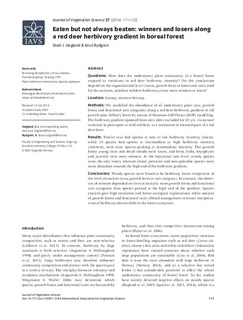| dc.description.abstract | Questions How does the understorey plant community in a boreal forest respond to variations in red deer herbivory intensity? Do the conclusions depend on the organizational level (taxon, growth form or functional trait) used for the analyses, and does red deer herbivory create more winners or losers? Location Svanøy, western Norway. Methods We modelled the abundance of all understorey plant taxa, growth forms and functional trait categories along a red deer herbivory gradient in old growth pine–bilberry forest by means of Huisman-Olff-Fresco (HOF) modelling. The herbivory gradient spanned from zero (deer excluded for 10 yr), via natural variation in plots open to wild red deer, to a maximum in forested parts of a red deer farm. Results Twelve taxa had optima at zero to low herbivory intensity (losers), while 25 species had optima at intermediate to high herbivory intensity (winners), with most species peaking at intermediate intensity. The growth forms young trees and dwarf shrubs were losers, and ferns, forbs, bryophytes and juvenile trees were winners. At the functional trait level, woody species were the only losers, whereas clonal, prostrate and non-palatable species were more abundant towards the high end of the herbivory gradient. Conclusions Woody species were found to be herbivory losers irrespective of the level of analysis (taxa, growth form or trait category). In contrast, the identities of winners depended on level of analysis: more growth forms and functional trait categories than species peaked at the high end of the gradient. Species analysis gave high resolution and better ecological explanations, while analysis of growth forms and functional traits offered management-relevant interpretations of herbivory-driven shifts in the forest ecosystem. | nb_NO |
